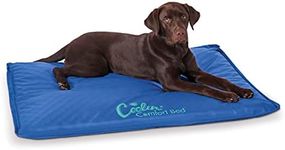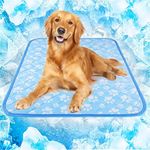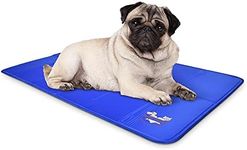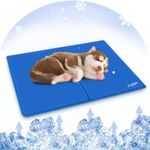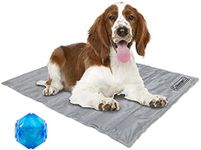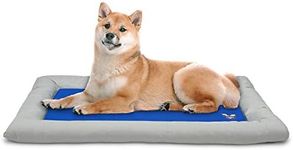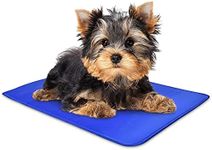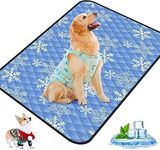Buying Guide for the Best Cooling Dog Mats
Choosing the right cooling dog mat is all about understanding your dog's needs and the environment where the mat will be used. Cooling mats help regulate your dog's body temperature, especially during hot weather or after exercise. To find the best fit, consider your dog's size, activity level, and where you plan to use the mat—indoors, outdoors, or while traveling. Pay attention to the materials, cooling mechanism, and ease of cleaning, as these factors will affect both your dog's comfort and your convenience.Cooling MechanismThe cooling mechanism refers to how the mat actually keeps your dog cool. There are generally three types: gel-based, water-filled, and pressure-activated mats. Gel-based mats use a special gel that absorbs heat from your dog's body, while water-filled mats rely on the cooling effect of water. Pressure-activated mats start cooling when your dog lies on them. Gel and pressure-activated mats are usually more portable and require less maintenance, while water-filled mats may need to be refilled and can be heavier. If you want something low-maintenance and easy to use, gel or pressure-activated mats are a good choice. For longer-lasting cooling, water-filled mats might be better, but they require more setup.
SizeSize is about making sure the mat is big enough for your dog to lie on comfortably. Mats come in various sizes, from small for toy breeds to extra-large for big dogs. If the mat is too small, your dog won't be able to stretch out and may not use it. If it's too large, it might be harder to move or fit in certain spaces. Measure your dog from nose to tail and choose a mat that gives them enough room to lie down fully. If you plan to use the mat in a crate or specific area, measure that space as well.
Material and DurabilityThe material and durability of the mat determine how long it will last and how comfortable it is for your dog. Most mats are made from nylon, PVC, or other synthetic fabrics that are easy to clean and resistant to scratches. Some are reinforced for extra durability, which is important if your dog likes to dig or chew. If your dog is gentle, a standard mat will do, but for more active or destructive dogs, look for mats labeled as puncture-resistant or heavy-duty.
PortabilityPortability is about how easy it is to move the mat from place to place. Some mats are lightweight and foldable, making them great for travel or outdoor use. Others are heavier or bulkier, which might be better for a permanent spot at home. If you want to take the mat on trips or move it between rooms, look for one that folds or rolls up easily.
Ease of CleaningEase of cleaning refers to how simple it is to keep the mat hygienic. Dogs can shed, drool, or have accidents, so a mat that wipes clean or has a removable, washable cover is very convenient. Some mats can be rinsed off with water, while others need to be spot-cleaned. If your dog is prone to messes or allergies, prioritize mats that are easy to clean and maintain.
SafetySafety is about making sure the materials and cooling agents used in the mat are non-toxic and safe for pets. Some mats use gels or chemicals that could be harmful if ingested, so always check for non-toxic labels and avoid mats with strong chemical smells. If your dog is a chewer, this is especially important—choose a mat with a tough outer layer and safe cooling materials.


